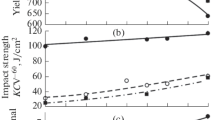Conclusions
-
1.
Additional alloying of steel 30N9K4MF with chromium (up to 3%) increases its resistance to tempering, the hardenability, and the quench hardness.
-
2.
The optimal Cr addition is 1–2%, ensuring a good combination of strength and toughness after oil quenching and high-temperature tempering (550°): σb > 155 kgf/mm3, σ0.2 ≥ 130 kgf/mm3, δ5 > 15%, ω>55%,a 1>7 kgf-m/cm2,a 1 −196=4–5 kgf-m/cm2,a 0.25=3.5–4.5 kgf-m/cm2,a p=2–3 kgf-m/cm2, T50=−140 to −165°.
Similar content being viewed by others
Literature cited
R. K. Guseinov and V. N. Zikeev, "Use of criteria for determining the structural strength to determine the optimal alloying of structural steels," in: Structural Strength of Steels and Alloys and Methods of Determining It [in Russian], MDNTP (1972), p. 146.
V. N. Zikeev, R. K. Guseinov, and A. P. Gulyaev, "Effect of carbon on the mechanical properties of nickel — cobalt steel," in: Special Steel and Alloys [in Russian], Tr. TsNIIChM, No. 4, Metallurgiya, Moscow (1975), p. 24.
I. Pascover and S. Matas, ASTM Special Technical Publication No. 370 (1965), p. 30.
R. K. Guseinov and V. N. Zikeev, "Medium-carbon structural steels with high strength and toughness alloyed with 9% Ni and 4% Co," Metalloved. Term. Obrab. Met., No. 1, 49 (1974).
A. P. Gulyaev, V. N. Zikeev, and R. K. Guseinov, "Effect of alloying with molybdenum, vanadium, and nitrogen on the properties of steel 30N9K4," Metalloved. Term. Obrab. Met., No. 3, 2 (1977).
Yu. A. Shul'te, Scale-Resistant Steels [in Russian], Metallurgiya, Moscow (1970), p. 28.
A. P. Gulyaev, "Separating notch toughness into its component parts by means of testing samples with different notches," Zavod. Lab., 33, No. 4, 473 (1964).
B. A. Drozdovskii, and Ya. B. Fridman, Effect of Cracks on the Mechanical Properties of Structural Steels [in Russian], Metallurgizdat, Moscow (1960).
V. D. Zelenova and I. V. Shermazan, "Electron microscopic analysis for quantitative determination of ductile components in fractures," Zavod. Lab.,38, No. 12, 1477 (1972).
L. M. Utevskii, Temper Brittleness of Steel [in Russian], Metallurgizdat, Moscow (1961), p. 32.
O. N. Mescherinova, V. N. Zikeev, and E. K. Novikova, "Susceptibility of structural steels to brittle fracture," in: Strength of Structural Steels [in Russian], MDNTP, Moscow (1967), p. 145.
Additional information
I. P. Bardin Central Scientific-Research Institute of Ferrous Metallurgy. Azerbaidzhan Polytechnic Institute. Translated from Metallovedenie i Termicheskaya Obrabotka Metallov, No. 5, pp. 47–50, May, 1979.
Rights and permissions
About this article
Cite this article
Zikeev, V.N., Guseinov, R.K. Effect of chromium on the properties of high-strength steel 30N9K4MF. Met Sci Heat Treat 21, 383–386 (1979). https://doi.org/10.1007/BF00780783
Issue Date:
DOI: https://doi.org/10.1007/BF00780783




